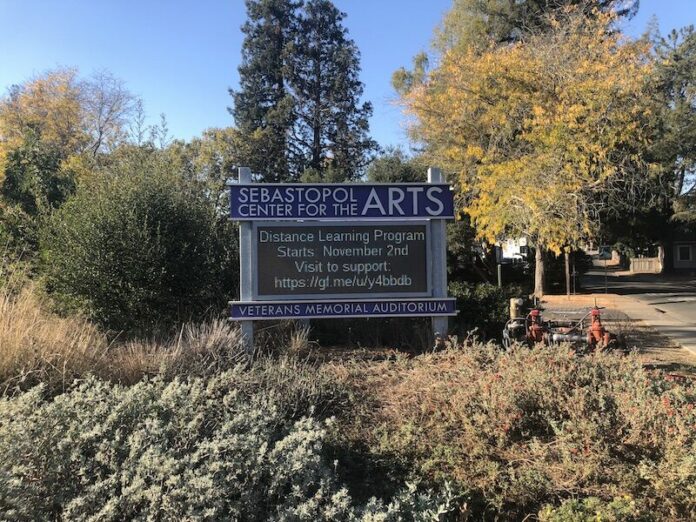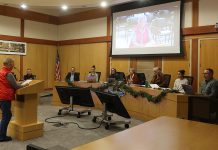Sebastopol Center for the Arts opened its new supervised distance learning program for elementary schoolers inside the cavernous Veterans Memorial Building in downtown Sebastopol on Monday, Nov. 2.
The six-week session, which includes arts enrichment classes, runs Monday through Friday from 7:30 a.m. to 5:30 p.m. to provide children in west county a safe, sanitized environment to do online schooling while their parents go to work. The program, which runs until Dec. 18, also works to alleviate social isolation and mental and emotional distress in children, according to the center’s press release.
Twenty-four students arrived for opening day, separated into two cohorts of no more than 12 children each, said Dana Swint, the center’s education manager, who organized the program. The first cohort consists of first and second graders, while third, fourth and fifth graders make up the second cohort, she said.
“But we already have more parents asking,” said Catherine Devriese, creative director of the center. “There is a request from parents. Sometimes the parent is not at home, they do two jobs, or sometimes the parents are at home, but they cannot work when there’s two or three kids around them.”
The center has the capacity to serve 46 students and maintain social distancing in the 17,000 square-foot facility, according to Swint.
“It’s a huge building and it was empty. No one was doing anything in there anymore. And we knew there was a need for these children to have some supervision and to find a place where they can go and at the same time have some art,” Devriese said.
Students arrive in the morning and settle into chairs spread out to seat two students per eight-foot table to keep social distance. Devriese said each student has their own container for markers and other school supplies to reduce contact.
Two distance learning assistants facilitate a cohort’s classroom setting and provide technical and academic support while students take their Zoom classes, Devriese said. Children have a morning break to eat a snack and continue their studies until lunch, returning to class afterwards or playing games outside if they are done with schooling for the day.
After-school arts programming starts at 3 p.m. each day, from dance and learning the ukulele to ceramics and nature-journaling and walking in Ives Park next door with professional artists, Devriese said. She said the arts instructors sharing their skills with elementary schoolers come from a pool of professionals who normally teach adults at the center. An after-school program leader and a volunteer accompany the cohort during their art session with the instructor.
The program’s staff had to undergo criminal background checks, fingerprinting and testing for COVID-19. Distance learning assistants also trained in first aid and CPR. The supervised distance learning program must maintain rigorous COVID safety measures to operate, Devriese said.
The distance learning assistants are educators with past experience like working at Boys & Girls Clubs of America, as classroom assistants in schools or nannying, Devriese said.
Swint worked with the County of Sonoma to submit a waiver for licensing as a childcare facility operating during school hours under the purple tier. She said this involved getting fire safety clearance, submitting a building layout and an emergency plan in case of a break COVID safety protocol, as well as plans for where the cohorts would be situated.
The cohorts are separated in different wings of the building.
“They don’t ever cross paths,” Swint said. “They have their own classroom space, their own restroom, their own entrance and exit point. And then their own patio spaces for recreational time.”
Devriese said students also have their own tables, their own sanitizer and their own learning assistants.
“The teachers from one don’t go to the other side. It’s always the same teachers,” she said.
“And they have to wear a mask at all times,” she continued. “All the time. They have to wash their hands when they go to the restroom, they have to wash their hands when they come back from the restroom. They have to wash their hands before they eat and afterwards. They have to constantly do hand-washing or hand-sanitizing.”
Keeping masks on wasn’t so hard for the kids on opening day, Swint said. “This is our first day and we’ve had to give very few reminders. They’re really great about it,” Swint said on Monday. “They also take a lot of initiative using the sanitizer. They’re pretty good about their spacing, so all in all, for a first day, we’re really, really happy with the outcome.”
Swint said the program staff tried to get the kids outside whenever possible. “They seem to have a lot of excitement around being around each other, a lot of energy and excitement around the art classes that are coming up this afternoon on our first day and I’m just really impressed by how apt they are at navigating what they’re doing,” she said.
“This is such a huge change that they’ve had to go through and with the guidance of the learning instructors, they’re doing an excellent job,” Swint finished.
Swint said the center partnered with the Sebastopol Union School District and that Superintendent Linda Irving allocated some of its CARES Act funding for the center to offer a sliding scale for high-need children at greater risk for learning loss. Enrollment costs $50 a day for a total of $1,500 for the six weeks, she said, but so far all families are paying either the low end of the sliding scale or receiving full scholarships.
“The district is heavily subsidizing this program with the CARE Act funds,” Swint said. The district also covers free lunch for the students. Swint said she learned from Irving that a significant number of Park Side Elementary School students have low-socioeconomic status, with many qualifying for free lunch and some living below the poverty line.
Meanwhile, Devriese created a GoFundMe to cover 50% subsidized and scholarship spots. The press release said this is to increase access for low-socioeconomic students, English Language Learner students and bilingual Spanish-speaking students, the press release said.
“So, currently we’re hoping to raise $69,000, which is about the operating cost of the program for one six-week session, so that’s covering the cost of our instructors, there’s the high ratio of instructor to student, and the length of the day,” Swint said. “We’re running a ten-hour program, so it’s a full, full day of programming for the arts instructors as well.”
The GoFundMe has raised a little over $6,000 so far, while others sent checks separately. “We’ve had some large donations from private donors, which has been really helpful to get us off the ground,” Swint said.
With the combined funding, the center is just breaking even on the program’s operational costs, Devriese said. Meanwhile, the center must explore fundraising for itself. “Because we still have a building and electricity to pay and the water to pay and the phone to pay and the staff. We have barely (any) staff but they still have to get paid.”
The education manager said she wishes the center could say whether they were offering the supervised distance learning program next semester, “but we’re working week by week, month by month to just see how things develop with the county and the status that we’re in, in the purple tier.”
She said the center serves students now to meet a critical need. “We’re working with our district to see what reopening plans might look like for the winter and beyond, so we’ll continue to collaborate and support the best way we can.”
To view the GoFundMe, click here.









